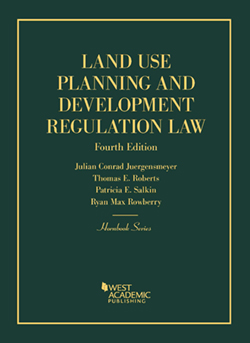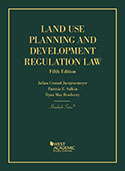
Land Use Planning and Development Regulation Law
Authors:
Juergensmeyer, Julian Conrad / Roberts, Thomas E. / Salkin, Patricia E. / Rowberry, Ryan Max
Edition:
4th
Copyright Date:
2018
- Preface
-
Chapter 1. AN INTRODUCTION TO LAND USE PLANNING AND CONTROL LAW
-
Chapter 2. COMPREHENSIVE PLANS AND THE PLANNING PROCESS
-
Chapter 3. LAND USE CONTROLS: HISTORY, SOURCES OF POWER, AND PURPOSES
-
Chapter 4. ZONING BASICS
-
Chapter 5. ZONING PROCESS: OBTAINING OR RESISTING DEVELOPMENT PERMISSION
-
Chapter 6. EXCLUSIONARY AND INCLUSIONARY ZONING
-
Chapter 7. SUBDIVISION AND PLANNED UNIT DEVELOPMENT CONTROL LAW
-
Chapter 8. BUILDING AND DEVELOPMENT CODES
-
Chapter 9. GROWTH MANAGEMENT AND SMART GROWTH
-
Chapter 10. CONSTITUTIONAL LIMITATIONS ON LAND USE CONTROLS
-
Chapter 11. REGULATION AND PROTECTION OF ENVIRONMENTALLY SENSITIVE LANDS
-
Chapter 12. AESTHETIC REGULATION AND HISTORIC PRESERVATION
-
Chapter 13. AGRICULTURAL LAND PROTECTION AND PRESERVATION
-
Chapter 14. NUISANCES
-
Chapter 15. PRIVATE LAND USE CONTROLS
-
Chapter 16. THE POWER OF EMINENT DOMAIN
- Table of Cases
- Index
- Publication Date: April 30th, 2018
- ISBN: 9781634593069
- Subject: Land Use
- Series: Hornbooks
- Type: Hornbook Treatises
- Description: This Hornbook introduces the fundamentals of land use planning and control law. Subjects covered include the planning process, zoning, development permission, subdivision control law, and building and housing codes. Discusses constitutional limitations and the environmental aspects of land use controls. Explores aesthetic regulation, historic preservation, and agricultural land protection.



